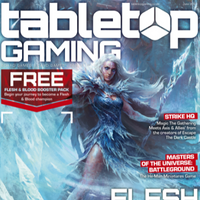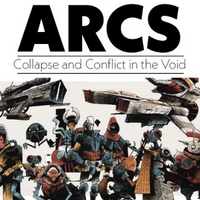27 January 2023
|
It's all in your mindset...
Although it may seem as if solo RPGing was invented as a response to pandemic social isolation, support for solo RPGing came right at the beginning. Gary Gygax created rules for “solo dungeon adventures” in 1975. Back then, the thought was that people would play solo if they couldn’t find a proper group, or perhaps as GM prep--and so it probably was. Yet solo rules continued to appear, in various forms, throughout various early editions of the original role-playing game.
There’s much to be said about solo RPG-so much, in fact, that I’ve written an entire book about it (Solo Game Master’s Guide, Modiphius, 2022). Here, I’m going to give a brief overview of what a solo RPG is, and discuss 3 central mindsets that a solo GM should bring to the table for maximum enjoyment. (Overall, I’ve identified 10 mindsets of solo GMs and you can read about the rest of them in my book.)
WHAT IS SOLO RPGING, ANYWAY?
Like a “regular” RPG, a solo RPG is game storytelling. It’s creating a simulated world, putting characters in it, and conducting actions that progressively reveal a story organically through gameplay. Often (but not always), dice mechanics are central to the fiction that emerges. Yet some solo RPGs such as journaling or writing-based games may not involve dice at all. Solo RPGs differ from conventional RPGs in one significant way: a solo RPG is creating a story with the help of RPG rules, conventions, and randomizers where you (the player) act both as the GM and the player.
The goals, rewards, and experiences of the solo GM and player are not the same as that of other GMs and players, nor are they trying to be. Having the proper mindset when sitting down to a solo session will greatly improve your satisfaction. We’re going to look at three of these mindsets now.
Mindset 1: everything is playing. If you are involved with an RPG rule set in any way, you are playing. Creating a character but never using it in a session is still experiencing an RPG world. That is playing. Acting out combat scenarios with pre-generated characters is playing. Choosing random trinkets for a character and creating a spell is playing, even if that’s all you do.
One of my first attempts at solo RPG was to use the original Traveller (Game Designer’s Workshop, 1981), and create a starship. I labelled a ship’s map and used random tables to imagine places it would go. That’s it. I never made characters. I never sent the ship anywhere. But I was playing an RPG, and it was great!
Mindset 2: words, not die rolling, should get you through narrative transitions. In solo RPG, the biggest challenge is the moment you need to transition from being a player to being the GM. These are generally times we reach for dice. For example, consider this question: “Can I or can’t I scale this wall without being seen?” It’s tempting to roll on an oracle table and get an answer like “Yes, but...” or “No” (or some such).
Imagine instead that you answer the question this way:
Look. What’s around? How high is the wall?
Feel. What’s the wall made out of? What skill level would be needed to scale it?
Listen. Do you hear others around?
Think. Is my character fit and healthy? Experienced in climbing? In a rush?
Answering these questions by thinking through what makes narrative sense, will yield an answer--one inherently organic to your developing story (in a way that a “yes/no” oracle answer never will be).
Mindset 3: play emotion, not mechanics. Story hangs on emotion. The more emotion, the more story. When sessions fail, it’s because they didn’t draw you into the story in an emotional way.
Focusing on the feeling of a situation or place (rather than the game mechanics of it) will inject narrative direction because feelings are what make you want to know what happens next in a story. And wanting to know “what happens next?” is a goal of effective sessions.
Consider these different designations of a forest: it’s an eerie forest as opposed to a magnificent forest. These descriptions provide entirely different feelings about the place – and nothing has even happened yet. Or imagine encountering an NPC who is tense versus one who is animated. These descriptions set the scene for two very different kinds of encounters.
Feelings can be injected into every story part by the use of evocative adjectives. Doing so is a simple yet effective strategy for maintaining emotional pull.
In essence, the challenge for the solo RPGer is to both distance yourself from the gameplay at the same time as you are immersed in it. Approaching the table as a lone gamer with the proper solo GM mindset is your strongest tool for creating and maintaining that childlike place of wonder and pure play to which all serious gamers aspire.

SCARLET HEROES
Scarlet Heroes by Kevin Crawford (2014). This versatile RPG, designed to support classic sword and sorcery adventuring with a lone hero (with or without a GM), contains a meaty section on solo gaming. In one book, you’ll find all the rules for playing the game, creating a world in the Red Tide setting, managing magic and monsters, as well as numerous oracles for solo play. These include random tables for urban, wilderness, and dungeon adventures. “Adventure tag” tables let you easily flesh out stories with enemies, friends, complications, and objects. If you’ve never done solo RPG before, this book is your best bet for one-stop shopping for everything you need. As an added benefit, most of the oracles and random tables in the book’s last section can be used with any other rule set to support solo RPG sessions.
IRONSWORN
Ironsworn by Shawn Tompkin (2018). The dark fantasy setting of Ironsworn comes alive in this flexible RPG. Created to support three types of play--guided (traditional table top with players and a GM); co-op (you and friend(s) banding together to overcome challenges in the world); or solo (you play a lone character fulfilling quests in a dangerous world). This game presents a rugged and treacherous setting at the end of the world where your character fulfills quests. Heavy on theme and emotion, the main rule book comes with numerous oracle tables to support solo play, as well as a bestiary and all rules for character and setting creation. With a storytelling focus and an emphasis on portraying a lone hero in a harsh land, Ironsworn enables dramatic storytelling. Combine with Ironsworn Delve (2020) rules for in-depth dungeon exploration.
SYMBAROUM
Symbaroum by Mattias Johnsson Haake and Mattias Lilja (2019) is a traditional (non-solo) RPG. The core rule book contains a rich setting, player’s guide, game master’s guide, as well as one adventure in 260 lavishly illustrated pages. You’ll need to stretch yourself as an RPG soloist to work with the rules. They contain no oracles or random tables but do have extensive lore about the game world, evocative and moody art, as well as narrative-based presentations of 30+ enemies. Start by reading about the world of Symbaroum, and study the map of Davokar. Imagine your character setting out from one of the detailed villages and towns and encountering one of the pre-generated NPCs. Let your imagination take you on a simple journey north, encountering some enemies along the way. With some basic randomized rolls (1-5 on a d10 = no and 6-10 = yes) you should be on your way to creating a solo story with this rule set.
About Geek Gamers
Geek Gamers is the host of YouTube’s premier solo RPG channel, “Geek Gamers”. In the “real world,” Geek Gamers has a PhD in Victorian literature, and is a book editor. She is the author of Solo Game Master’s Guide (Modiphius, 2022) and Wanderings: A d88 Gothic Roll and Read Table (90th Street Productions, 2022) as well as various articles about wargaming, modernist literature, and book publishing.
Looking for more?

This review came from Tabletop Gaming Magazine, which is home to all of the latest and greatest tabletop goodness. Whether you're a board gamer, card gamer, wargamer, RPG player or all of the above, find your copy here.
Get your magazine hereRead More...

If you want to read more about one of the most hotly anticipated games of the year, check out our interview with Cole Wehrle on ARCS! A new game from the designer of Root and Oath, and we've got all you need to know.
To infinity and beyond
Sometimes we may include links to online retailers, from which we might receive a commission if you make a purchase. Affiliate links do not influence editorial coverage and will only be used when covering relevant products







